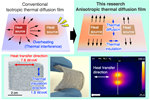NIMTE researchers develop bio-based polyester nanocomposite
Multifunctional bio-based MXene@CNT/PBF nanocomposite’s high performance and reprocessability shows promise as a substitute for petroleum-based polymers.
Biorenewable MXene@CNT/PBF nanocomposites with high performance and reprocessability. Source | NIMTE
A research team led by Professor Zhu Jin from the (NIMTE, Ningbo, China) of the Chinese Academy of Sciences (CAS) has synthesized a novel bio-based polyester nanocomposite with comprehensive performance and reprocessability through an innovative in situ catalysis strategy. The study was published in .
Renewable bio-based materials show promise in replacing traditional polymers. The 2,5-furanodicarboxylic acid (FDCA)-based polyesters, in particular, are reported to be among the most promising packaging materials for achieving the sustainability and recyclability of these materials. However, their comprehensive properties are not yet comparable to petrochemical-based polymers due to inadequate molecular or microstructure design.
Researchers at NIMTE used 2D MXenenanosheets to wrap 1D carbon nanotube (CNT) fiber, obtaining dendritic MXene@CNT heterostructures with improved dispersion and structure stability. According to researchers, this hetero-structured MXene@CNT can serve as a catalyst, nucleator and interface enhancer of polyesters.
Embedding the dendritic hetero-structured MXene@CNT in a bio-based polybutylene furandicarboxylate (PBF) matrix, the MXene@CNT/PBF (MCP) nanocomposite was thus synthesized via in situ catalytic polymerization and hot pressing.
Thanks to its multi-scale energy dissipated structure, the developed MCP nanocomposite achieved high mechanical strength (≈101 MPa), stiffness (≈3.1 GPa) and toughness (≈130 MJ m−3).
Compared with most commercial bio-based materials and polymers, NIMTE researchers report that the MCP nanocomposite shows optimal UV resistance, solvent resistance and enhanced gas barrier performance against oxygen, CO2 and water. Moreover, the nanocomposite can retain 90% of its strength after five recycling cycles, indicating its improved reprocessability.
The catalysis-interfacial strengthening integration strategy introduced in this study opens new avenues for advancing high-performance polyester materials.
Related Content
-
All-recycled, needle-punched nonwoven CFRP slashes carbon footprint of Formula 2 seat
Dallara and Tenowo collaborate to produce a race-ready Formula 2 seat using recycled carbon fiber, reducing CO2 emissions by 97.5% compared to virgin materials.
-
Trends fueling the composites recycling movement
Various recycling methods are being considered for composites, from novel dismantling and processing, to building capacity and demonstrating secondary use applications.
-
Plant tour: Daher Shap’in TechCenter and composites production plant, Saint-Aignan-de-Grandlieu, France
Co-located R&D and production advance OOA thermosets, thermoplastics, welding, recycling and digital technologies for faster processing and certification of lighter, more sustainable composites.






